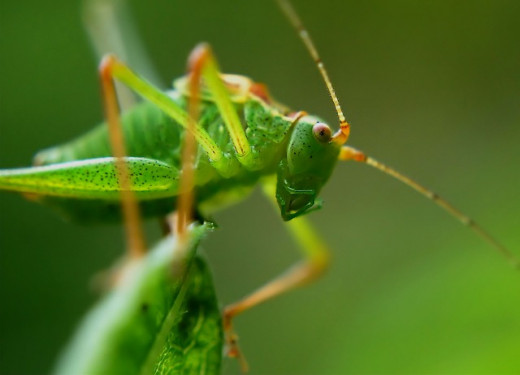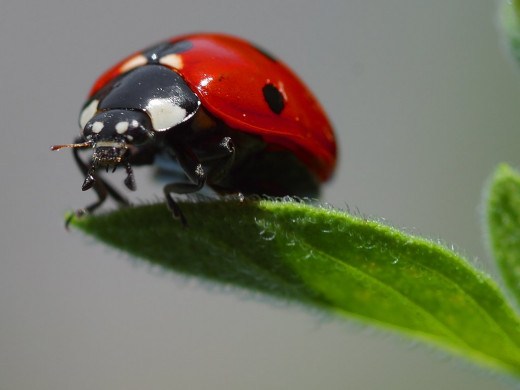Photographing The Miniature World of Insects

"Insects (from Latin insectum, a calque of Greek ἔντομον [éntomon], "cut into sections") are a class of invertebrates within thearthropod phylum that have a chitinous exoskeleton, a three-part body (head, thorax and abdomen), three pairs of jointedlegs, compound eyes and one pair of antennae. They are among the most diverse groups of animals on the planet, including more than a million described species and representing more than half of all known living organisms." Wikipedia

There is a wonderful and very intriguing miniature world of insects in most any place that features greenery like any garden and most fields.
You only have to know where to look and what equipment to have.
For the majority of insect photography you should use a macro capable lens. It does not have to be just a lens usable only for macros.
A good zoom lens will do and this may actually help you get some images from jittery insects by allowing you to stand some distance away while you shoot.
"Despite their reputation as pests, the trillions of insects, bugs, and spiders that inhabit the Earth can make some of the most fascinating and dramatic close-up photography subjects. Insects and their tiny environments offer the macro photographer an unlimited amount of color, texture, and physical architecture to explore." Frank H. Phillips
First you need to scout some locations where you can see that insects congregate. These are mostly location that have plenty of vegetation and specially flowers.
Even if you see some insects that you are not particularly interested in like aphids, be aware that ladybugs, which are very photogenic, like to feast on them. Locating the prey can lead to its predator.
Try to conduct some research into the insects that visit your region as well as researching their habits; are they diurnal or nocturnal, what type of flowers or vegetation do they prefer and so on.
Keep in mind that most insects need to warm up with the Sun's rays before they become fully active. This is knowledge that gives you an edge.
The best times to capture their images are during the early mornings,especially if it's a cold morning or after a frost.
Try to be on location with plenty of time to get set up and focus on one general area but be ready to move if you see a possible subject.
Mulch composed of leaves and other plant material is a good sign that some insect might be dwelling in it. Although I usually do not like to disturb any natural setting, slightly moving the mulch might dislodge some subjects for you to photograph.
You can also bait a spot with some fruits like apples, very ripe bananas, strawberries, pineapples and others.


You will need a small ring light. This is a small flash unit in the shape of a ring that fits over the lens element and provides soft illumination to macro subjects.
If you do not count with one at least have some reflectors handy like a small white card which you can use to shed some light unto the subject.
A tripod with the ability of being placed very low to the ground is paramount if doing macro but not so if using a zoom.
Choose a tripod that allows its center column to be removed. These are best for close ups and when laying on the ground.
When you focus on one subject, carefully get in position and avoid sudden movements, especially with your hands. Most insects can sense the change in air pressure caused by movement and will quickly flee.
If you choose to do some night insect photography, then set up a small light close to the ground or a plant and wait for them to approach. Many are attracted by light and will come rather close to it.
Be aware that you need to calibrate your sensor/film for the type of light you use unless you want a distinct tinge to show up on the pictures.
Do you think you've gained a new appreciation for photographing insects?

Do not overlook much easier targets like snails. They rarely hide unless touched and getting good pictures is rather easy.
Yes they are not really insects but if your main targets prove to be too skittish then at least you have some good substitutes.
Try to watch for some that are on flowers or greens.
Most of their coloration is rather drab, with some notable exceptions such as the Polymita Cuban Land Snail, so positioning them against a bright and colorful backdrop provides for a good contrasting view.
The same fruits that will attract some insects can be sued to attract them although they most often prefer dead leaf materiel they will feed on fresh matter as well.
Many species of crawling insects can also prove to be good subjects but avoid touching them as quite a few extrude foul tasting and smelling fluids as a means of self defense.
Some photographers have made it a specialty to photograph one particular species or genre.
Talented Ukrainian photographer Vyacheslav Mishchenko has a series of photographs featuring snails and his technique as well as his patience has yielded many really beautiful images of this lowly creature.
The pictures seem to give these creatures a life of their own often appearing in a whimsical pose and seemingly as if simply just exploring the world around them..
He often photographs them against interesting and colorful backdrops and in unusual situations making his project one truly worth looking at.
- Beautiful Bugs: How to Do Macro Insect Photography
Despite their reputation as pests, the trillions of insects, bugs, and spiders that inhabit the Earth can make some of the most fascinating and dramatic close-up photography subjects. Insects and their tiny environments offer the macro photographer

Like the work of Vyacheslav Mishchenko, you can use the final results in a series or a book whether in print or in an eBook format.
These prints are usually in demand by many scientific and nature minded publications and some can make interesting home or office decor.
They can also be used as screen savers and for many commercialization purposes.
But whatever the purpose you see fit to put the images to think about this; most photographic projects whether they gain you a sale or not always serve to enhance your skills and most will let you experience new techniques and approaches to do the art better.
So go out there and capture your own miniature world of insects.
© 2014 Luis E Gonzalez










